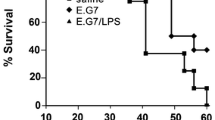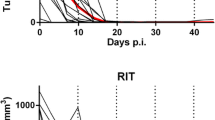Abstract
The effect of radiation therapy combined with lymphoid cells against spontaneous murine fibrosarcoma (FSa-II) was investigated bothin vivo andin vitro. In thein vivo experiment, syngeneic C3H mice were divided into 3 groups. Animals in the first group were injected with 1 x 105 tumor cells into the right hind leg. Animals in the second and third groups were injected with 1 x 105 tumor cells mixed with 1 x 107 normal lymphoid cells (NLC) or effector lymphoid cells (ELC), respectively. ELC were obtained from spleen and lymph nodes of FSa-II-bearing mice and incubatedin vitro for 40 hr to eliminate suppressor T cell function. NLC were obtained from normal mice and incubated in the same way. Irradiation was given using137Cs unit 3 days after cell inoculation. 12 out of 14 mice (85.7%) inoculated with tumor cells mixed with NLC did not show any tumor growth at 60 Gy local irradiation. 12 out of 21 mice (57.1 %) inoculated with tumor cells alone and 6 out of 10 (60%) with tumor cells mixed with ELC rejected tumors at the same radiation dose. This synergistic effect with NLC was not observed when NLC was inoculated after irradiation, indicating that lymphoid cells should be in contact with tumor cells before irradiation. In the51Cr release assay, lymphoid cells obtained from whole body irradiated (WBI) mice showed 17.8% lysis without irradiation and 28.8% lysis at 5 Gy irradiation. Untreated NLC showed almost no cytotoxic effect at the same radiation dose. This synergistic effect disappeared when WBI lymphoid cells were treated with anti asialo GM1 and complement. These results suggested that NK cells might be important in this synergistic effect with irradiation. To obtain a sufficient level of synergistic effect by in vitro combined treatment of mixed tumor cell - NLC culture and irradiation - incubation for more than 12 hrs and 8 hrs appeared to be necessary before and after irradiation, respectively.
Similar content being viewed by others
Abbreviations
- BRM:
-
biological response modifier
- ELC:
-
effector lymphoid cell
- FCS:
-
fetal calf serum
- HBSS:
-
Hanks balanced salt solution
- NK cell:
-
natural killer cell
- NLC:
-
normal lymphoid cell
- TC:
-
cytotoxic T cell
- TS:
-
suppressor T cell
- WBI:
-
whole body irradiation
References
Gillis S, Smith KA. Long term culture of tumor-specific cytotoxic T cells. Nature 1977; 268: 154–156.
Gillis S, Baker PE, Ruscetti FW, Smith KA. Longterm culture of human antigen-specific cytotoxic T-cell lines. J Exp Med 1978; 148: 1093–8.
Goldenbery GM, Gaffar SA, Bennett GS, Bearch JL. Experimental radio immunotherapy of a xenografted human colonic tumor (GW-39) producing carcinoembryonic antigen. Cancer Res 1981; 41: 4354–43.
Rowland GF, Axton CA, Baldwin RW, Brown JP, Corvalan JRF, Embleton MJ, Gore VA, Hellstron I, Jacobs E, Marsdem CH, Pimm MV, Simonds RG, Smith W. Antitumor properties of vindesine-monoclonal antibody conjugates. Cancer Immunol Immunother 1985; 19: 1–7.
Okamoto H, Minami M, Shoin S. Experimental anticancer studies part XXXI. On the streptococcal preparation having potent anticancer activity. Jpn J Exp Med 1966; 36: 175–86.
Old LJ, Clarker DA, Benacerraf B, Goldsmith M. The reticuloendothelial system and the neoplastic process. Ann NY Acad Sci 1968; 164–280.
Haskill S, Ritter F, Becker S. Effect of C. parvum on intratumor immunity to the T1699 mammary adenocarcinoma. J Immunol 1980; 125: 454–8.
Suit HD, Sedlacek R, Wanger M, Orsi L, Silbricic V, Rothman KJ. Effect of corynebacterium on the response to irradiation of C3H fibrosarcoma. Cancer Res 1976; 36: 1305–14.
Urano M, Rice L, Epstein R, Suit HD, Chu AM. Effect of wholebody hyperthermia on cell survival, metastasis frequency, and host immunity in moderately and weakly immunogenic tumors. Cancer Res 1983; 43: 1039–43.
Winn HJ. Immune mechanism in homotransplantation. J Immunol 1961; 86: 228–36.
Olden HT, Oldham R, Ortaldo JR, Herberman RB. Standardization of the chromium-51 release, cell-mediated cytotoxicity assay: Cryopeseruation of mouse effector and target cells. J Natl Cancer Inst 1977; 58: 611–2.
Habu S, Fukui H, Shimamura K, Kasai M, Nagai Y, Okumura K, Tamaoki N.In vivo effects of anti-asialo GM1. Reduction of NK activity and enhancement of transplanted tumor growth in nude mice. J Immunol 1981; 127: 34–38.
Kasai M, Yoneda T, Habu S, Maruyama Y, Okumura K, Tokunaga T.In vivo effect of anti-asialo GM1 antibody on natural killer activity. Nature 1981; 291: 334–5.
Laux D, Lausch RN. Reversal of tumor-mediated suppression of immune reactivity by incubation of spleen cells. J Immunol 1974; 1121: 1900–8.
Kiesling R, Wigzell H. An analysis of the murine NK cells as to structure, function and biologic relevance. Immunol Rev 1979; 44: 165–208.
Anderson RE, Warner NL. Ionizing radiation and the immune response. In: Dixon FL, Kunkel HG, ed. Advances in immunology, Vol. 24. Academic Press, 1976; 215–335
Palma L, Di Lorenze N, Guidetti B. Lymphocytic infiltrates in primary glioblastoma and recidivous gliomas. Incidence, fate, and relevance to prognosis in 288 operated case. J Neurosurg 1978; 49: 854–61.
Moroson H, Nowakkowski J, Schechter M. Enhanced lymphocyte-mediated killer of tumor cells after tumor irradiationin vivo. Int J Radiat Biol 1978; 33: 437–82.
Kingsley DPE. An interesting case of possible abscopal effect in malignant melanoma. Br J Radiol 1975; 48: 863–6.
Nobler MP. The abscopal effect in malignant lymphoma and its relationship to lymphocyte circulation. Radiology 1969; 93: 410–2.
Kadish AS, Ghossein NA. Natural cytotoxicity in patients undergoing radiation therapy. Am J Clin Oncol 1983; 6: 53–9.
Grimm EA, Mazumder A, Zhang HZ, Rosenberg SA. Lymphokine-activated killer cell phenomenon. Lysis of natural killer resistant fresh solid tumor cells by interleukin 2-activated autologous human peripheral blood lymphocytes. J Exp Med/ 1982; 155: 1823–41.
Author information
Authors and Affiliations
Rights and permissions
About this article
Cite this article
Nakagawa, K., Yoshida, F., Omori, N. et al. The effect of radiation therapy combined with natural killer cells against spontaneous murine fibrosarcoma. Biotherapy 2, 69–75 (1990). https://doi.org/10.1007/BF02172078
Received:
Accepted:
Issue Date:
DOI: https://doi.org/10.1007/BF02172078




